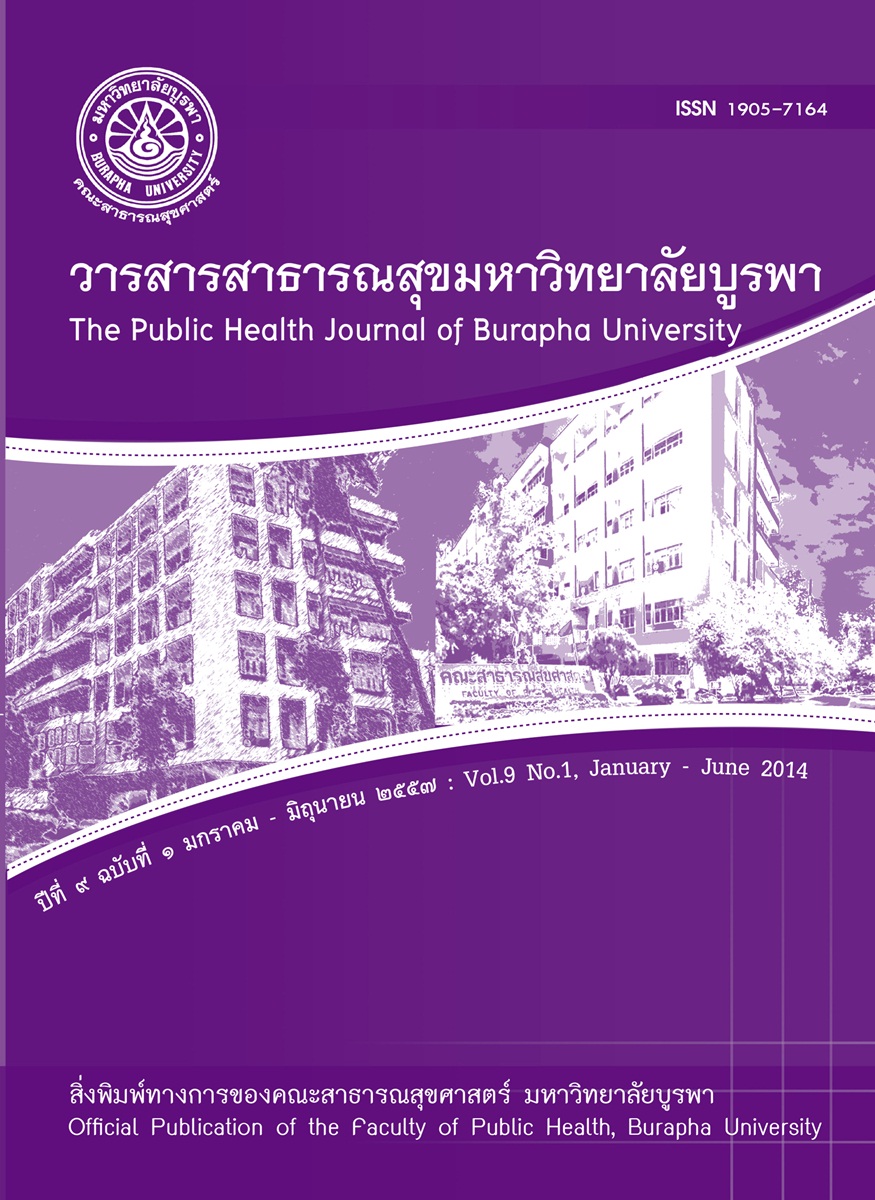ผลลัพธ์ของการกำกับตนเองในการรับประทานอาหารและการเดินเร็วเพื่อควบคุมน้ำหนักของหญิงที่มีน้ำหนักเกิน
Main Article Content
บทคัดย่อ
การวิจัยกึ่งทดลองนี้มีวัตถุประสงค์เพื่อศึกษาผลลัพธ์ของการควบคุมกำกับตนเองในการรับประทานอาหาร และการออกกำลังกายด้วยการเดินเร็วในหญิงที่มีน้ำหนักเกิน (BMI ≥ 23 กิโลกรัมต่อตารางเมตร) โดยประยุกต์แนวคิดการกำกับตนเอง กลุ่มตัวอย่างเป็นเพศหญิง อายุ 35 - 59 ปีที่มีน้ำหนักเกิน อาศัยในตำบลบ่อวิน อำเภอศรีราชา จังหวัดชลบุรี ที่มีคุณสมบัติตามที่กำหนดไว้ นำมาจับคู่ 3 ด้าน ได้แก่ อายุ สถานภาพสมรส และรายได้ หลังจากนั้นทำการสุ่มอย่างง่าย จำนวน 25 คู่ แบ่งเป็น 2 กลุ่ม สุ่มเป็นกลุ่มทดลอง และกลุ่มควบคุม กลุ่มละ 25 คนโดยกลุ่มทดลองได้รับการกำกับตนเองในการรับประทานอาหาร และการเดินเร็ว เป็นเวลา 12 สัปดาห์ ส่วนกลุ่มควบคุมดำเนินชีวิตตามปกติ วัดผลก่อนและหลังการทดลอง รวบรวมข้อมูลโดยใช้การชั่งน้ำหนัก วัดส่วนสูง วัดเส้นรอบเอว แบบสอบถามข้อมูลส่วนบุคคล พฤติกรรมการรับประทานอาหาร และการออกกำลังกายด้วยการเดินเร็ว สถิติที่ใช้ในการวิเคราะห์ข้อมูล คือ การแจกแจงความถี่ ร้อยละ ไคสแควร์ ค่าเฉลี่ย ส่วนเบี่ยงเบนมาตรฐาน และการวิเคราะห์ความแปรปรวนร่วม
ผลการวิจัยพบว่าการกำกับตนเองในการรับประทานอาหารและการเดินเร็ว มีผลทำให้กลุ่มทดลองมีค่าเฉลี่ยน้ำหนัก ค่าดัชนีมวลกาย และเส้นรอบเอวน้อยกว่ากลุ่มควบคุมอย่างมีนัยสำคัญทางสถิติที่ระดับ .05 (p < 0.05) และมีค่าเฉลี่ยพฤติกรรมการรับประทานอาหารและการออกกำลังกายด้วยการเดินเร็วสูงกว่ากลุ่มควบคุมอย่างมีนัยสำคัญทางสถิติที่ระดับ .05 (p < 0.05)
ผลการวิจัยนี้มีข้อเสนอแนะว่า ควรนำการกำกับตนเองในการรับประทานอาหารและการเดินเร็วไปใช้กับวัยผู้ใหญ่อายุ 35 – 59 ปี ที่มีน้ำหนักเกินในชุมชน เพื่อเป็นการป้องกันภาวะเสี่ยงจากการเจ็บป่วยด้วยโรคที่สัมพันธ์กับภาวะน้ำหนักเกิน
Outcomes of Self-regulation on Eating Behavior and Brisk Walk for Weight Control in Overweight Women
The purpose of this study was to examine the effects of self- regulation on eating behavior and brisk walking in overweight women. Quasi- experimental research design was used in the study with intervention and control groups. The sample was overweight women aged 35 -59 years old who lived in Bowin subdistict, Sriracha district, Chon Buri province. Match pairs concerning age, marital status and income were conducted. Twenty-five subjects were randomly selected into the experimental group and the control group. The experimental group practiced self-regulation on eating behavior and brisk walking for twelve weeks and the control group still have normal life style. Pre-test and post- tests were administered. The instruments for data collection were questionnaires to capture data related to demographic data, eating behavior and brisk walking, body weight, height and waist circumference measurement records. Frequency, percentage, mean, standard deviation and chi-square were employed to analyze data. The analysis of covariance were ued to body weight, body mass index and waist circumference compare in both group.The research results showed that body weight, body mass index and waist circumference measurement of the experimental group were significantly less than those of the control group and mean scores of eating behavior and brisk walking of the experimental group were significantly higher than those in the control group. (p < 0.05)
The finding suggested that self-regulation on eating behavior and brisk walking can be applied to overweight community dwelling adults whose age ranged 35 - 59 years. This will help prevent the risk of sicknesses associated with overweight.

